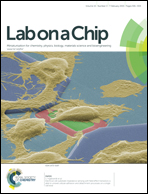Rapid and continuous magnetic separation in droplet microfluidic devices†
Abstract
We present a droplet microfluidic method to extract molecules of interest from a droplet in a rapid and continuous fashion. We accomplish this by first marginalizing functionalized super-paramagnetic beads within the droplet using a magnetic field, and then splitting the droplet into one droplet containing the majority of magnetic beads and one droplet containing the minority fraction. We quantitatively analysed the factors which affect the efficiency of marginalization and droplet splitting to optimize the enrichment of magnetic beads. We first characterized the interplay between the droplet velocity and the strength of the magnetic field and its effect on marginalization. We found that marginalization is optimal at the midline of the magnet and that marginalization is a good predictor of bead enrichment through splitting at low to moderate droplet velocities. Finally, we focused our efforts on manipulating the splitting profile to improve the enrichment provided by asymmetric splitting. We designed asymmetric splitting forks that employ capillary effects to preferentially extract the bead-rich regions of the droplets. Our strategy represents a framework to optimize magnetic bead enrichment methods tailored to the requirements of specific droplet-based applications. We anticipate that our separation technology is well suited for applications in single-cell genomics and proteomics. In particular, our method could be used to separate mRNA bound to poly-dT functionalized magnetic microparticles from single cell lysates to prepare single-cell cDNA libraries.


 Please wait while we load your content...
Please wait while we load your content...